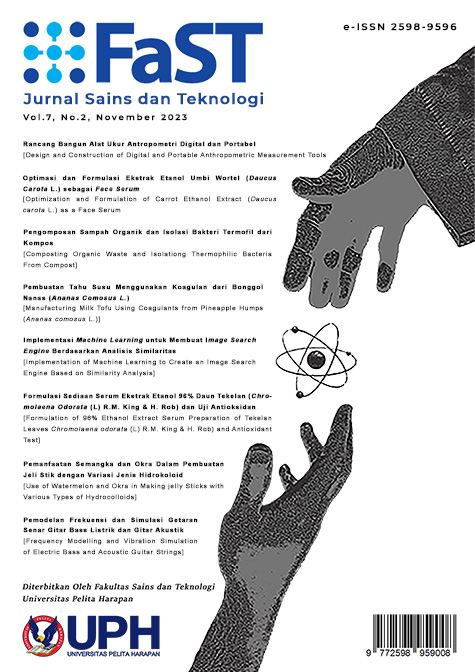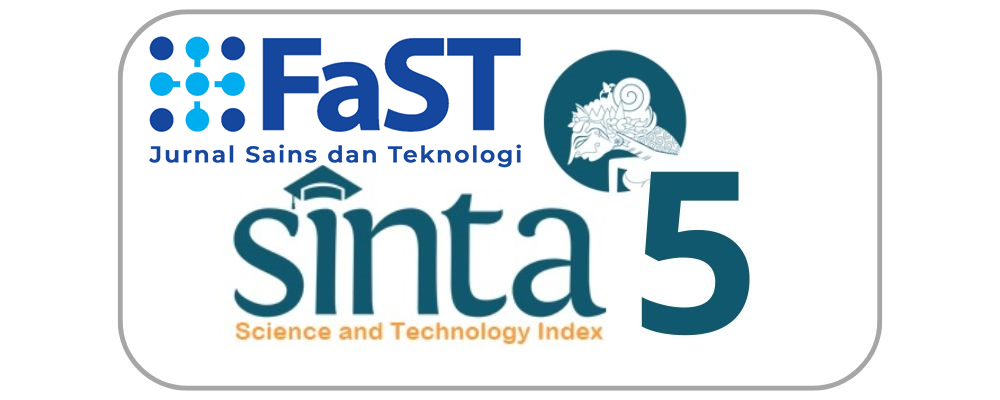RANCANG BANGUN ALAT UKUR ANTROPOMETRI DIGITAL DAN PORTABEL [DESIGN AND CONSTRUCTION OF DIGITAL AND PORTABLE ANTHROPOMETRIC MEASUREMENT TOOLS]
DOI:
https://doi.org/10.19166/jstfast.v7i2.7569Keywords:
anthropometry, digital, measuring tool, portableAbstract
In the Work System Design Laboratory at UPH, there are anthropometric measuring tools for standing position and sitting position. Based on the tools evaluation, it was found that they were less efficient because of the need for repeated tool adjustments. Furthermore, two observers were needed to collect anthropometric data and they had to read the scale manually. Therefore, a new digital and portable anthropometric measuring tool was developed to overcome the problem. The Gea HT721 measuring instrument was chosen as an alternative to a new anthropometric measuring tool that uses ultrasonic ranging technology to measure distances. A supporting tool (similar to a caliper) was also developed to support the anthropometric measurement process. An evaluation of the new anthropometric measuring tool was carried out by calculating the average percent error and a comparison of the total time for data collection. The results of the average percent measurement error was 0.58%. According to the paired t-test, there was no significant difference in the average of measured body dimensions using the new and the previous tools. The new anthropometric tools can reduce data collection time by 32% for standing positions and 11% for sitting positions.Bahasa Indonesia Abstract:
Pada Laboratorium Analisis Perancangan Kerja (APK) di UPH terdapat alat ukur antropometri posisi berdiri dan posisi duduk. Berdasarkan evaluasi alat antropometri tersebut, ditemukan bahwa alat kurang efisien karena membutuhkan penyetelan alat yang berulang yang juga membutuhkan lebih dari satu pengamat saat pengambilan data. Selain itu, pengamat sering mengalami kesulitan pembacaan hasil pengukuran manual pada meteran. Oleh karena itu, dibuat alat antropometri jenis baru yang bersifat digital dan portabel. Alat ukur Gea HT721 dipilih sebagai alternatif alat antropometri baru yang menggunakan teknologi ultrasonic ranging untuk mengukur jarak. Setelah itu, dirancang dan dibuat suatu alat pendukung yang menyerupai jangka sorong untuk mendukung proses pengukuran data antropometri. Evaluasi alat antropometri baru dilakukan dengan menghitung rata - rata persen error, serta perbandingan total waktu pengambilan data. Hasil rata - rata persen error pengukuran adalah 0,58%. Hasil uji paired t test menunjukkan bahwa tidak terdapat perbedaan signifikan antara rata-rata hasil pengukuran dimensi tubuh menggunakan alat ukur antropometri jenis baru dengan hasil pengukuran menggunakan alat yang lama. Berdasarkan perbandingan total waktu pengambilan data terdapat penurunan waktu sebesar 32% untuk data antropometri posisi berdiri dan 11% untuk data antropometri posisi duduk.
References
Anjani, R. D., Nugraha, A. E., Sari, R. P., & Santoso, D. T. (2021). Perancangan alat bantu kerja dengan menggunakan metode antropometri dan material selection pada industri sepatu. Jurnal Teknologi, 13(1), 15-24.
AZoM (2021). How 3D Sensing applications rely on VCSEL accuracy and performance. Retrieved July 7, 2023 from https://www.azom.com/article.aspx?ArticleID=20877
Christiani, A, Kristina, H. J., Ishak, & Pratama, A. (2009). Pembuatan alat ukur antropometri. In Proceeding National Conference on Applied Ergonomics (CAE) (pp.36-41). Jurusan Teknik Mesin dan Industri Universitas Gadjah Mada.
Chuan, T. K., Hartono, M., & Kumar, N. (2010). Anthropometry of the Singaporean and Indonesian populations. International Journal of Industrial Ergonomics, 40(4), 757-766. https://doi.org/https://doi.org/10.1016/j.ergon.2010.05.001.
Iridiastadi, H. & Yassierli (2014). Ergonomi: Suatu Pengantar. Penerbit PT Remaja Rosdakarya.
Kasim, F. (2008). Metodologi Penelitian Biomedis (2nd ed.). Penerbit Danamartha Sejahtera Utama.
Kopecky, M., Krejcovsky, L., & Svarc, M. (2014). Anthropometric measuring tools and methodology for the measurement of anthropometric parameters. Palacky University.
Prabhaker, M., Pandey, C. M., Singh, U., Gupta, A., Sahu, C. & Keshri, A. (2019). Descriptive statistics and normality tests for statistical data. Annals of Cardiac Anaesthesia, 22(1), 67-72. https://doi.org/10.4103/aca.ACA_157_18
Utama, I. C. (2020). Sistem navigasi robot pembantu orang cacat pada mode serve [Thesis], Universitas Komputer Indonesia, Bandung.
Widodo, L., Aritanti, S., & Kurniawan, F.A. (2018). Perancangan stasiun kerja ergonomis pada stasiun kerja printing CV. Karyamitra Lestari. Jurnal Ilmiah Teknik Industri, 6(1), 29 - 34. https://doi.org/10.24912/jitiuntar.v6i1.3021
Widiyanto, A. M. (2013). Statistika Terapan. Konsep dan aplikasi dalam penelitian bidang pendidikan, psikologi dan ilmu sosial lainnya. Penerbit PT Elex Media Komputindo.
Zetli, S., Fajrah, N. & Paramita, M. (2019). Perbandingan data antropometri berdasarkan suku di Indonesia. Jurnal Rekayasa Sistem Industri, 5(1), 23-34. https://doi.org/10.33884/jrsi.v5i1.1390
Downloads
Published
Issue
Section
License
“Authors who publish with this journal agree to the following terms:
1) Authors retain copyright and grant the journal right of first publication with the work simultaneously licensed under a Creative Commons Attribution License (CC-BY-SA 4.0) that allows others to share the work with an acknowledgement of the work's authorship and initial publication in this journal.
2) Authors are able to enter into separate, additional contractual arrangements for the non-exclusive distribution of the journal's published version of the work (e.g., post it to an institutional repository or publish it in a book), with an acknowledgement of its initial publication in this journal.
3) Authors are permitted and encouraged to post their work online (e.g., in institutional repositories or on their website). The final published PDF should be used and bibliographic details that credit the publication in this journal should be included.”





